Top 10 Internal Communication Tools For Your Team

Table of contents
Ever feel like getting everyone on your team on the same page is harder than it should be?
Well, internal communication can be tricky. Messages get lost, people get left out of the loop, and before you know it, things start to fall apart.
But it doesn’t have to be this way. The right tools can make a huge difference. We’ve done the research and found the top ten internal communication tools that help you work in-sync with your colleagues, and become more efficient at collaboration. Let’s check them out.
What are Internal Communication Tools?
These are apps that help team members share information and work together. They offer features like task management, file sharing, video calls, and instant messaging. For example, Hiver allows teams to manage shared email inboxes directly from Gmail, assign tasks, and track progress.
10 Tools to Simplify Your Team’s Internal Communication
Here’s a list of the 10 best tools to streamline internal communication for your team.
| Tool | Starting Price | Free Trial | G2 Rating |
| Hiver | $15 per user per month | 7 days | 4.6 ⭐ |
| Slack | $7.25 per user per month | 90 days | 4.5 ⭐ |
| Asana | $10.99 per user per month | 30 days | 4.3 ⭐ |
| Zoom | $149.90 per user per year | 30 days | 4.5 ⭐ |
| Document360 | $149/project per month | 14 days | 4.7 ⭐ |
| Helpjuice | $120/month up to 4 users | 14 days | 4.5 ⭐ |
| ProofHub | $45/ month unlimited users | 14 days | 4.5 ⭐ |
| Chanty | $4 per user per month | NA | 4.5 ⭐ |
| Trello | $5/user per month | 14 days | 4.4 ⭐ |
| Microsoft Teams | $4 per user per month | 30 days | 4.3 ⭐ |
1. Hiver
Hiver is a tool that adds collaboration and automation features to your Gmail and Outlook inbox. When you install Hiver, you can turn emails into tasks, track their progress, and collaborate with colleagues – without leaving your inbox.
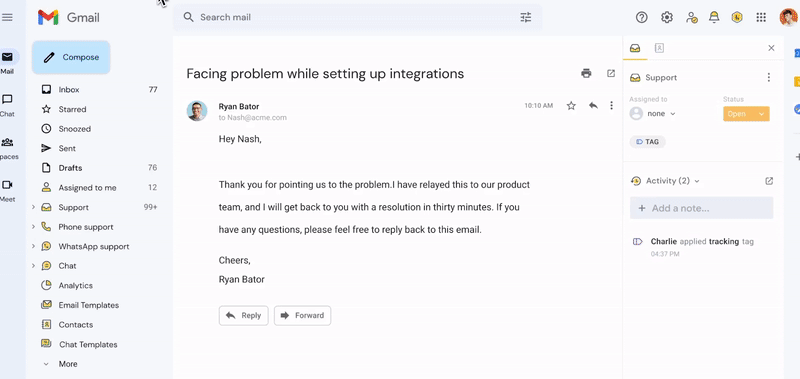
Key Features:
- Notes: Teams can add comments directly to emails, so discussions happen without sending more internal emails or switching to other tools. Everything stays in one place.
- Shared Drafts: This feature allows team members to work together on email responses. Everyone can edit a single draft, making sure responses are perfect and agreed upon.
- Automation and Workflow Management: Hiver helps automate repetitive tasks like sorting and assigning emails, saving time and effort.
- Views: Your inbox can be customized to highlight important emails and keep track of tasks, so that nothing gets lost.
- Analytics and Reporting: Hiver provides insights into how quickly emails are responded to, how long it takes to resolve them, and how work is divided within the team.
Pricing:
Hiver offers four pricing options.
- Free forever plan
- Lite: $19 per user per month
- Pro: $49 per user per month
- Elite: $79 per user per month
2. Slack
Slack is a collaborative workspace that transforms how teams work together. It brings all your communication into one place, making it easy to share ideas, make decisions, and move projects forward. With Slack, you can create channels for different topics, projects, or teams, ensuring everyone has the information they need.
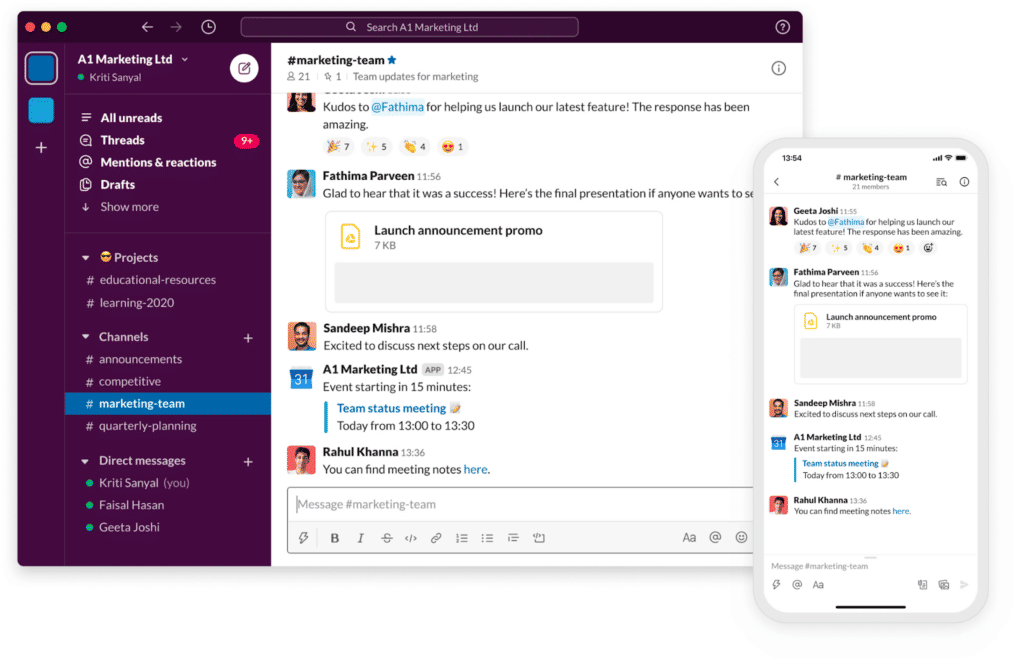
Key Features:
- Direct Messaging: Besides group channels, Slack lets you have private one-on-one conversations. Perfect for quick check-ins or confidential conversations.
- File Sharing: You can share all kinds of files, like documents, images, and videos, right in the chat. It’s super handy for keeping everything in one place.
- Search Functionality: Slack’s search feature is powerful, making it easy to find specific messages, files, or people quickly. This is a lifesaver when you need info fast.
Pricing:
Slack offers three types of pricing options.
- Pro: $7.25 per user per month
- Business+: $12.50 per user per month
- Enterprise Grid: Price on request
How to Connect Slack with Gmail?
3. Asana
Asana is a handy tool for both team communication and project management. It helps everyone stay organized and work together smoothly by providing a central space to manage tasks, projects, and goals.
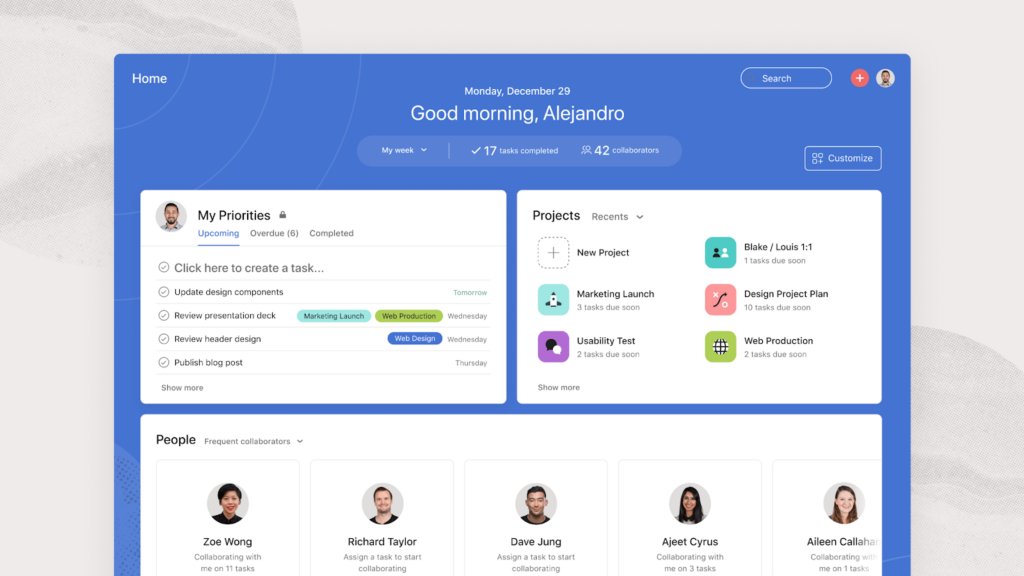
Key Features:
- Asana AI: Create tasks, assign work, suggest edits, and more, to reduce back and forth discussions – with Asana AI.
- Project Management: Track all work from start to finish, and get visibility into every stage of the project.
- Project Visualization: Asana offers different views like lists, boards (Kanban style),calendars, and timelines. This allows you to choose the view that works best for your project.
Pricing:
Asana offers four types of pricing options.
- Basic: Free Forever Plan
- Premium: $10.99/user/month
- Business: $24.99/user/month
- Enterprise: Contact for pricing
How to Integrate Asana with Gmail?
4. Zoom
Zoom is popular for its video conferencing features and is typically used by businesses in education, B2B, healthcare and software. It serves both internal and external communication use cases. It’s high-quality video and audio make team meetings, client discussions, and webinars smooth and effective.
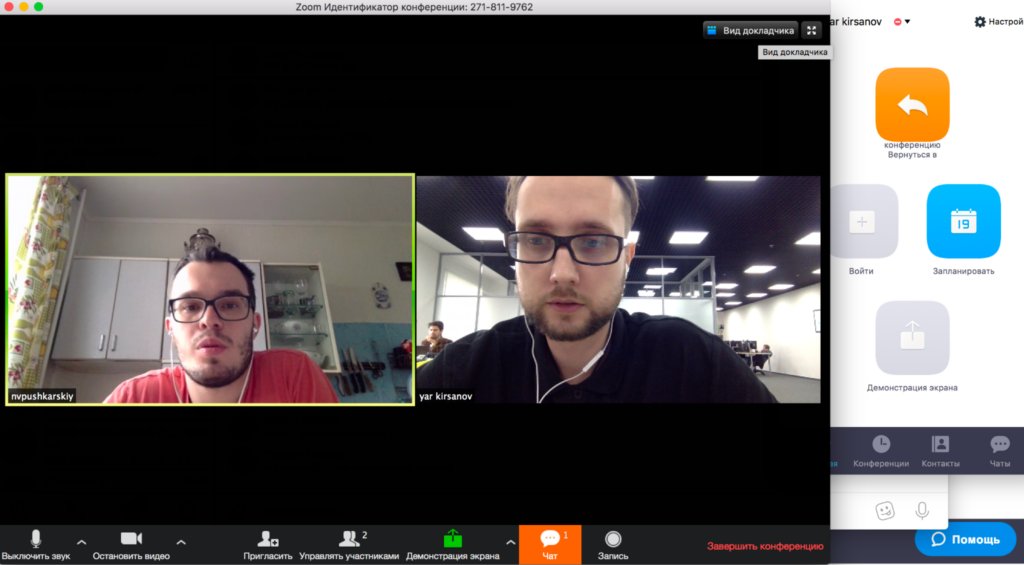
Key Features:
- Zoom AI Companion: This tool helps draft emails and chat messages, as well as summarize meetings. It’s integrated into all Zoom Workplace products, so you don’t need to switch between windows.
- Zoom Rooms: Ideal for hybrid teams, Zoom Rooms allow both in-person and remote participants to communicate in real time. They provide a seamless conference room experience, making it easy to start meetings, book rooms, and share information.
- Zoom Scheduler: It helps you connect with clients quickly and schedule appointments. Whether you need one-to-many, one-to-one, or multi-person scheduling, it’s easy to schedule events with this feature.
Pricing:
Zoom offers five types of pricing options.
- Basic: Free Plan (Allows meetings up to 40 minutes per meeting and 100 attendees)
- Pro: $149.90/year/user
- Business: $199.90/year/user
- Business Plus: Contact for pricing
- Enterprise: Contact for pricing
5. Document360
Document360 is an AI-powered knowledge base platform that simplifies collaboration and centralizes knowledge. You can easily create knowledge bases, technical documentation, API documentation, user manuals, SOPs, wikis, and more.
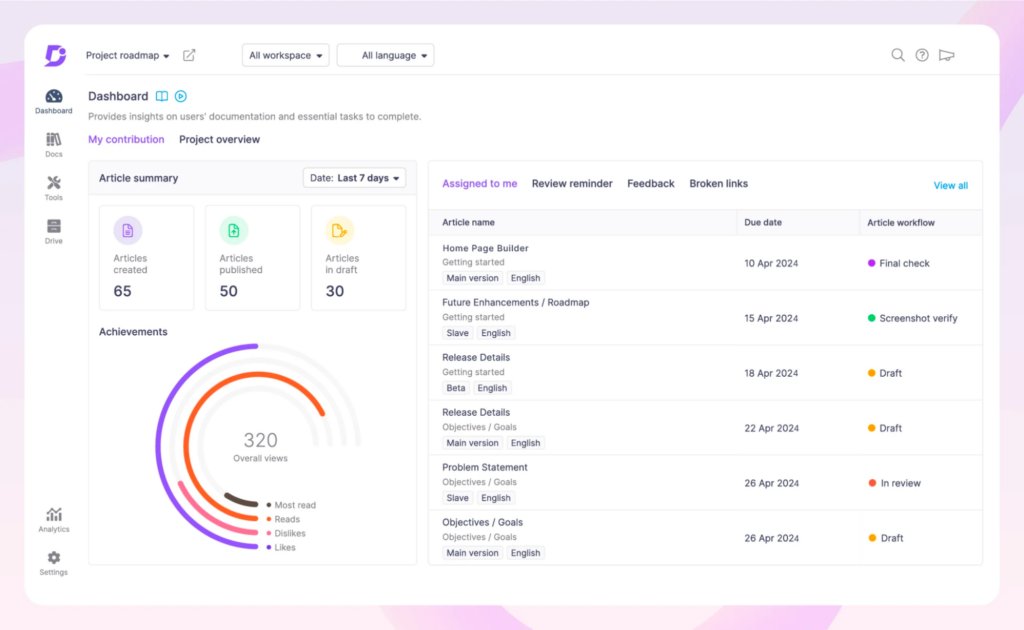
Key Features:
- Intuitive Block Editor: This block editor makes creating content easy, and allows users to leave inline comments.
- Customization Centralized Hub: The customization center gives users control over the look and feel of their documents. Teams can easily change layouts, color schemes, fonts, and branding elements to match their company’s brand identity.
- Markdown Text Editor: You don’t need to be a developer to format text documents. The simple Markdown editor lets you use common formatting tools like headers, emphasis, lists, images, and links.
Pricing:
Document360 offers the following pricing plans.
- Standard: $149/project/month billed yearly
- Professional: $299/project/month billed yearly
- Business: $399/project/month billed yearly
- Enterprise: $599/project/month billed yearly
6. Helpjuice
HelpJuice is a knowledge base platform that enhances knowledge sharing within your company. It’s ideal for staff training, onboarding new customers, enabling self-service, and sharing knowledge both inside and outside your organization.
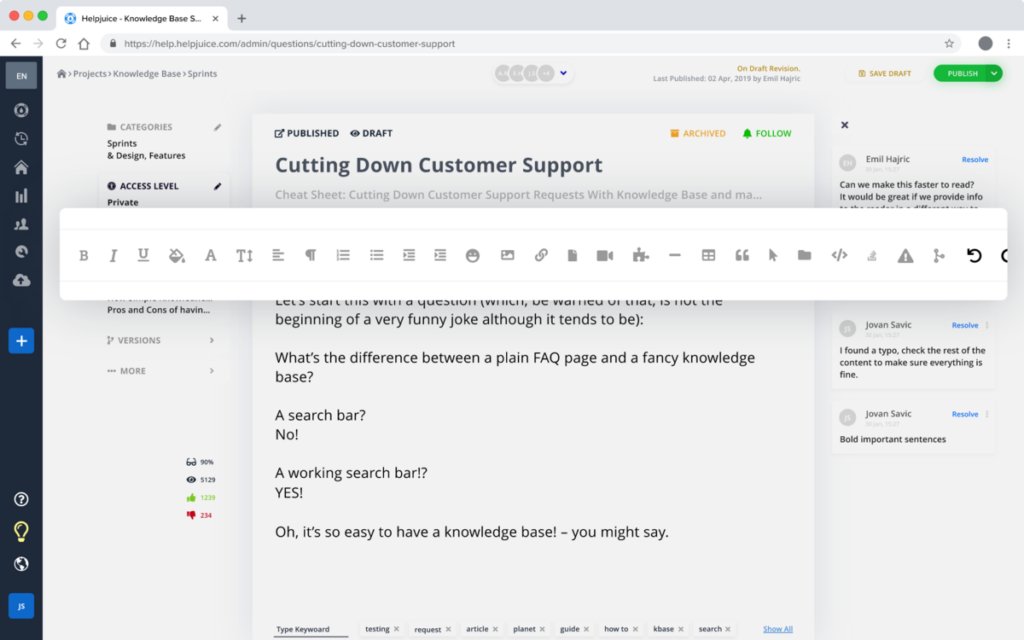
Key Features:
- Unlimited Authoring & Formatting: Enjoy easy and unlimited text formatting, and upload photos, videos, and other media, all within Helpjuice’s robust editing panel.
- Publish Multiple Versions: Effortlessly work with multiple versions of the same article using the same editor, and switch between them as needed.
- Structure Content: Organize your content with user-friendly folders and categories, including primary and secondary categories for each article.
Pricing:
Helpjuice offers the following pricing options.
- Starter: $120/month
- Run-Up: $200/month
- Premium Limited: $289/month
- Premium Unlimited: $659/month
7. ProofHub
ProofHub is a cloud-based tool used by teams for project management and communication. It gives a clear view of tasks and progress, allowing teams to collaborate from any device and location.
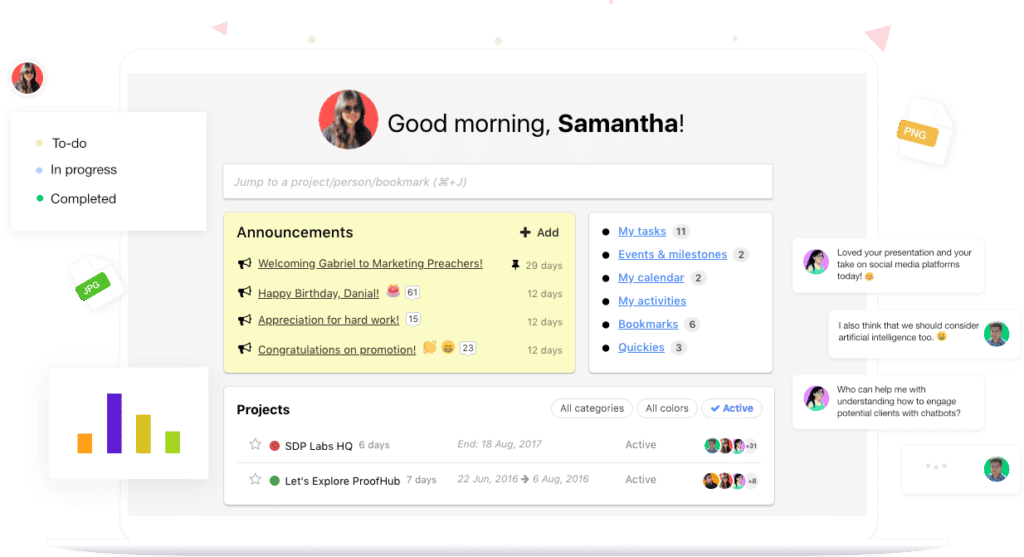
Key Features:
- Task Management: You can create tasks, set deadlines, and assign them to team members. Tasks can be organized in lists or on a Kanban board.
- Time Tracking: Features a time tracking tool for monitoring the amount of time spent on tasks.
- Notes and Wikis: Provides a centralized space for storing all project-related information, notes, and documentation.
Pricing:
ProofHub offers the following pricing options.
- Essential: $45 per month for unlimited users
- Ultimate Control: $89 per month for unlimited users
8. Chanty
Chanty is a cloud-based collaboration tool, which helps you chat with team members, share files, send instant messages, and make group or individual audio/video calls. It integrates with various applications like Google Drive, Dropbox, Trello, GitHub, Zapier, Jira, Asana, and more.
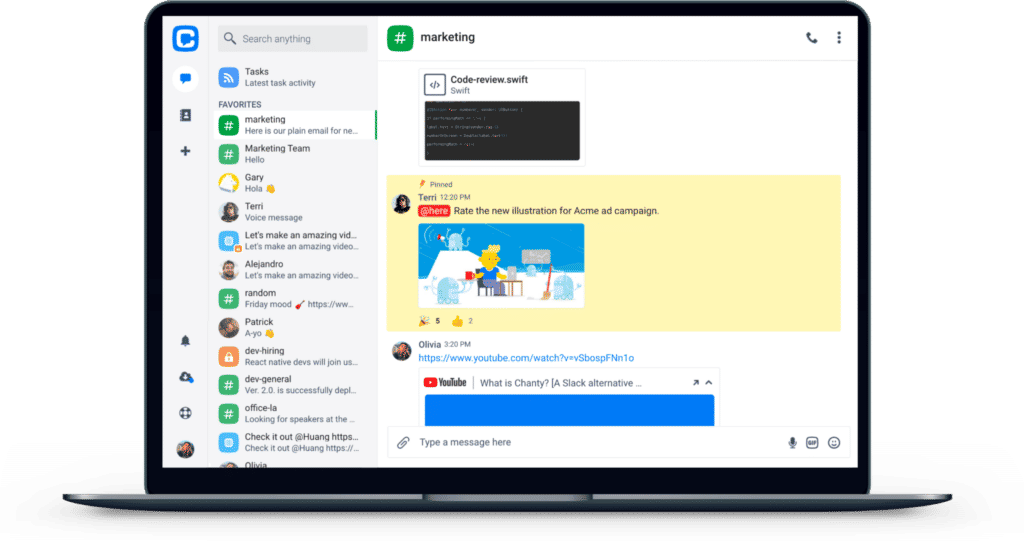
Key Features:
- Kanban View: This feature lets you view tasks in rows and columns, similar to popular project management tools.
- Set Deadlines: You can set up reminders for approaching deadlines and manage each task’s priority and status.
- Teambook: All shared content, discussions, pinned messages, and tasks are stored in Teambook. It’s a central place to quickly access your chat history and find team members easily.
Pricing:
Chanty offers the following pricing options.
- Free Plan: For up to 5 team members
- Business: Starts at $4 per user per month
9. Trello
Trello is a project management and communication tool known for its visual way of organizing tasks. It uses boards, lists, and cards to help teams create, prioritize, and track tasks in an interactive manner. This setup makes it simple for everyone to see project progress, communicate about tasks, and work together effectively.
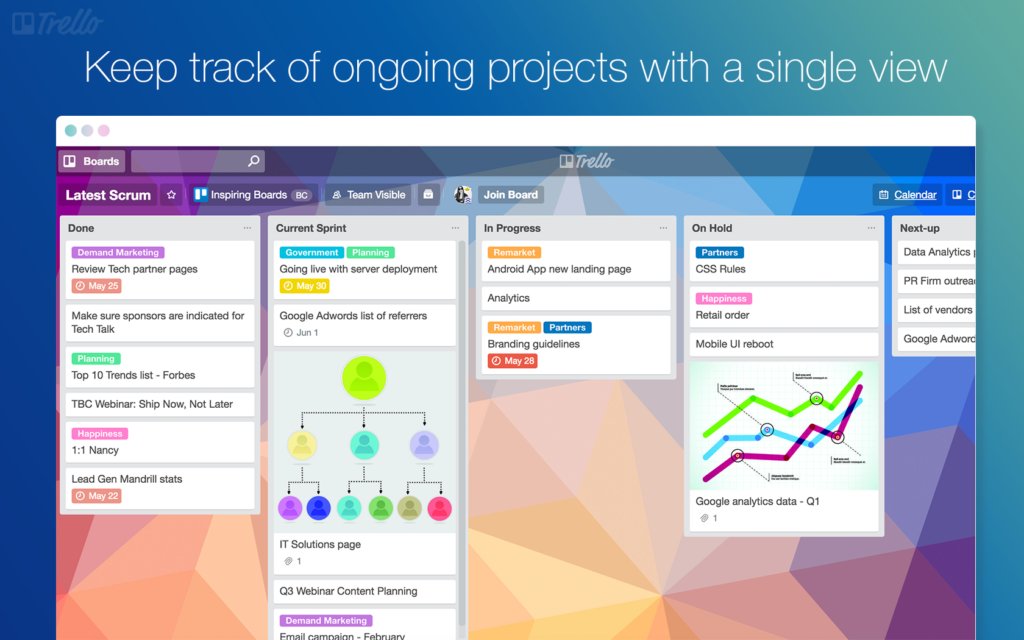
Key Features:
- Automation: Trello can automate any task with rules, buttons, and commands. Their built-in automation tool, Butler, spots recurring tasks and suggests automations you can enable.
- Views: See your work from different angles with Board, Timeline, Table, Calendar, Dashboard, Map, and Workspace views.
- Labels and Tagging: Cards can be categorized using labels, and team members can be tagged in comments and tasks.
Pricing:
Trello offers four pricing plans.
- Forever Free Plan (for basic use)
- Standard: $5/user per month
- Premium: $10/user per month
- Enterprise: $17.50/user per month
10. Microsoft Teams
Microsoft Teams is a chat-based workspace that’s part of Office 365. The tool makes it easy for teams to chat, plan tasks, and work together. Moreover, as Teams integrates with other Office apps such as Word, Excel, and PowerPoint, you can work with colleagues on documents together – at the same time.
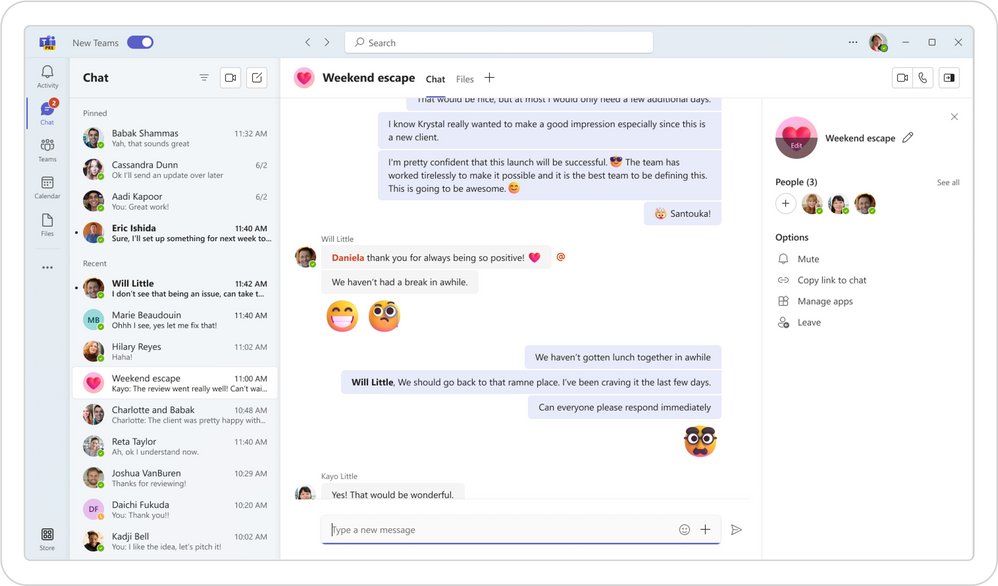
Key Features:
- Video Conferencing: Use Microsoft Teams to meet and work together securely from anywhere. You can organize video conferences by choosing presenters, turning off background noise, and keeping out uninvited guests.
- Screen Sharing: You can show your entire desktop or just a specific item like a presentation, app, or browser window.
- Webinars: Host webinars and events for up to 1,000 attendees. You can customize presenter bios, settings, and themes to create and schedule your webinars smoothly.
Pricing:
Microsft Teams offers the following pricing options:
- Microsoft Teams Essentials: $4 per user per month
- Microsoft 365 Business Basic: $6 per user per month
- Microsoft 365 Business Standard: $12.50 per user per month
Benefits of Internal Communication Tools
Internal communication tools can really help a team become more efficient. Here’s how:
- Better Teamwork: These tools make it easy for team members to work together on projects, share ideas, and give feedback. This is great for teams with remote workers or people in different locations.
- Save time and effort: By making communication and collaboration faster, these tools help save time on emails and meetings. Real-time messaging, file sharing, and task tracking help everyone work more efficiently.
- Clear Information Flow: Good communication tools ensure important information gets to the right people at the right time, whether it’s a company-wide announcement or a project update.
- Higher Employee Engagement: When employees feel connected and informed, they’re more engaged with their work. Features like discussion forums encourage interaction and build a sense of community.
- Easy Knowledge Sharing: These tools make it simple to share knowledge and best practices within the company, leading to more innovative ideas and a better-skilled workforce.
- Centralized Information: Many of these tools provide a central place for documents, policies, and other important resources, making it easy for everyone to find what they need.
Did You Know: Utilizing tools like Hiver and Slack for internal communication can significantly reduce the reliance on emails, leading to more efficient team collaboration.
Conclusion
To sum it up, having good internal communication tools can really improve how your team works together. They help everyone stay connected, share information easily, and get things done faster.
Take Hiver, for example. It turns your inbox into a powerful collaboration hub, allowing you to assign tasks, track progress, and work together on emails.
Frequently Asked Questions (FAQs)
Q: How do these tools improve productivity?
A: They cut down on long email chains and meetings, make it easy to find important info, and help everyone stay organized and on track.
Q: Can these tools work with other software we use?
A: Yes, many of them can integrate with other tools like project management apps, CRMs, and file storage services.
Q: What should I look for in an internal communication tool?
A: Look for something easy to use, that works with other tools you use, has good security, can scale with your team, and has the features you need like video calls, task management, and file sharing.
Q: How does Hiver help with internal communication?
A: Hiver lets you turn emails into tasks, add notes, share drafts, and see task statuses. This keeps everyone on the same page and reduces back-and-forth on email.
Q: Can Hiver manage tasks?
A: Yes, you can create tasks from emails, assign them to team members, set due dates, and track progress, all within Gmail or Outlook.
Q: Is Hiver easy to set up and use?
A: Yes, it’s user-friendly and integrates directly with Gmail or Outlook. The setup is straightforward, and the interface is easy to understand, so teams can start using it quickly.
Get started with Hiver today. Free for 7 days.

































